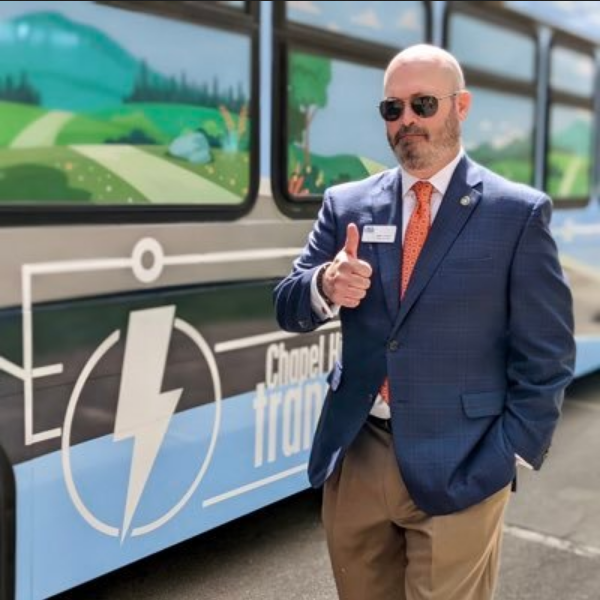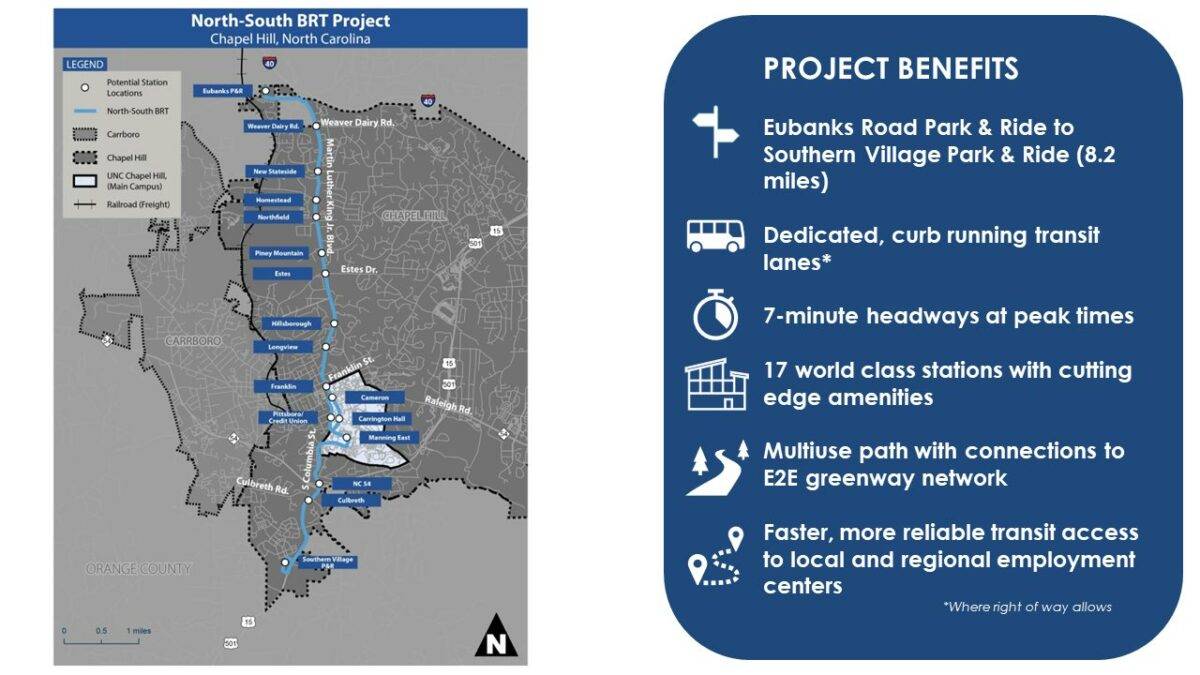In March, President Biden recommended that the federal government provide $138.3 million to build the North-South Bus Rapid Transit route along Martin Luther King, Jr. Boulevard in Chapel Hill. This represents the single largest transit investment in Chapel Hill’s history, and will make our community—which already punches well above its weight in terms of transit ridership—the smallest town in the United States with a BRT line.

We spoke to Brian Litchfield, Chapel Hill’s Transit Director, about this news.
How did you react when you heard this news?
Well, this is really exciting news, not only for Chapel Hill Transit, but for our funding partners, the Town of Chapel Hill, the Town of Carrboro, and the university. And it’s exciting news for the region. It’s a big deal for any community in the state, but certainly one the size of Chapel Hill to be included in the President’s budget.
We think it’s the largest amount of transportation money that Chapel Hill has ever received from the federal government.
As far as we’re aware, it’s the largest amount that Chapel Hill has ever received from the federal government. If it’s not, it’s one of the largest – certainly in recent or modern history for Chapel Hill Transit.
We’ve had pretty good success receiving federal grants but it’s certainly the largest, by far, that we’ve ever seen.
That’s awesome. So what does this mean for Chapel Hill?
The NSBRT is a landmark project for Chapel Hill Transit and the Town of Chapel Hill are funding partners. And it’s been a priority not only for our local funding partners for well over a decade, but it’s also been a priority regionally.
So being able to be eligible for federal funding for a project like this is certainly a major step. And in order to be potentially considered for an actual congressional allocation, you’ve got to get in the President’s budget first, for projects like this.
So being able to achieve that success after working on this – our team and our community and our advocates and stakeholders for over a decade – is a big deal. A project like this doesn’t get to this point without a strong team working on it. So first of all, I give credit to our BRT team, which has (as you can imagine) changed over the years because of the time that it’s taken and people on the team members have come and gone.
But most recently, Matt Cecil and Caroline Dwyer, and Nick Pittman – those three that have been really working on this and really helped us move from our previous position to being in a position to where we can be in the President’s budget.
And then I think the term ‘small but mighty’ has been used for because we say team, and sometimes people think that’s a lot of people. And for us, it’s three folks. And all three of them, in addition to helping work on this project have other jobs and responsibilities that they do for us. So this is significant for them – a significant achievement, significant success, and this project doesn’t move forward without local support, which we’ve been fortunate to have from all of our local funding partners, and then also regionally and then we’ve certainly seen strong support from our federal partners.
So what’s next? We know you need some additional funding. What happens now?
This is a major step, but we still have plenty of work to do. So we’re in the process of doing 60% design. That will take about another year to complete and then when 60% design is done, you have to get to 90% before you’re able to move to construction. But with all of that going on, the first step for transportation projects like this is to get included in the President’s budget.
And then there’s a congressional allocation that needs to take place, which usually happens as part of the transportation bill. And so once this is down – that’s not a guarantee of funding, but it signifies that you’re eligible for that funding in the future. So we’re going to continue to work on this project and meet all of the steps that we need to meet in the federal process, which is complex, as you might imagine. And then we also have to continue to move regionally and at the federal level to continue to try and secure the congressional appropriation or appropriations.
So those things all need to be done. In order to get the federal money, you also have to have local ones. So this project is about $200 million rounded-up (for ease of doing these calculations – and that’s an estimate of construction money. Those numbers could go up or down based on inflation or other factors in the year it’s actually constructed and built. But we’ve got $146 million of that from federal sources – again, we’re still waiting to secure that. But then the rest of that has to come from other sources. So we have all of that aside from $5 million of that.
An additional $5 million would help us with this project to go with the basics. But we need another $40 million to be able to create a dedicated and protected multi-use sidepath and all of the things that we want to see to make it a fully completed project. So we need to continue to work on securing the local funding.
But again, we’re in a much better position than we’ve ever been in with this project. And we’ve got quite a lot of resources already allocated.
It seems like a step-by-step process where you have to do step A before you can do step B and so on. Is there anything else you want to add?
I think the important thing to remember is that rapid transit is in the name, and there’s certainly a big component of improving bus service by adding dedicated bus lanes and making other improvements to make it easier for people to use general transit and make more trips.
But another very important part of this is the bicycle and pedestrian improvements.Today that corridor is heavily used by folks generally driving, personal vehicles, but it’s not really a great street if you’re biking or walking or doing something else outside of a vehicle or bus. There’s sections of sidewalk that are missing or don’t connect. If you’re bicycling, unless you’re a really competent biker, you’re probably not going to ride in that corridor. But this project is going to build a multi use path, which is about an 11 foot wide path that’s going to be separated from the travel lanes, that will make it much safer for folks to walk and bike. And then we’re also going to build a sidewalk on the opposite side of that as well, too. So those improvements are significant, by themselves, as things that the town has identified as a priority, but wouldn’t be able to fund either by themselves or even perhaps with us because of the cost and scope of them. So being able to do the bus improvements and bicycle pedestrian improvements are about equally as important.
From our perspective, we’re excited to see those things happen, along with being able to support things like affordable housing that’s in the corridor and then providing accessibility. That’s great.
It will connect with the different trail greenways that are in and around Southern Village, and other ones too. Those things are as important.
Where can people learn more?
The website nsbrt.org. There’s all kinds of information there. Feel free to check that out. And of course, if they’ve got questions or want to know more and take a deeper dive into this, our team that I mentioned earlier would certainly be happy to talk to folks about that.

